Hong Li
Vision Transformer for Robust Occluded Person Reidentification in Complex Surveillance Scenes
Oct 31, 2025Abstract:Person re-identification (ReID) in surveillance is challenged by occlusion, viewpoint distortion, and poor image quality. Most existing methods rely on complex modules or perform well only on clear frontal images. We propose Sh-ViT (Shuffling Vision Transformer), a lightweight and robust model for occluded person ReID. Built on ViT-Base, Sh-ViT introduces three components: First, a Shuffle module in the final Transformer layer to break spatial correlations and enhance robustness to occlusion and blur; Second, scenario-adapted augmentation (geometric transforms, erasing, blur, and color adjustment) to simulate surveillance conditions; Third, DeiT-based knowledge distillation to improve learning with limited labels.To support real-world evaluation, we construct the MyTT dataset, containing over 10,000 pedestrians and 30,000+ images from base station inspections, with frequent equipment occlusion and camera variations. Experiments show that Sh-ViT achieves 83.2% Rank-1 and 80.1% mAP on MyTT, outperforming CNN and ViT baselines, and 94.6% Rank-1 and 87.5% mAP on Market1501, surpassing state-of-the-art methods.In summary, Sh-ViT improves robustness to occlusion and blur without external modules, offering a practical solution for surveillance-based personnel monitoring.
Light of Normals: Unified Feature Representation for Universal Photometric Stereo
Jun 24, 2025Abstract:Universal photometric stereo (PS) aims to recover high-quality surface normals from objects under arbitrary lighting conditions without relying on specific illumination models. Despite recent advances such as SDM-UniPS and Uni MS-PS, two fundamental challenges persist: 1) the deep coupling between varying illumination and surface normal features, where ambiguity in observed intensity makes it difficult to determine whether brightness variations stem from lighting changes or surface orientation; and 2) the preservation of high-frequency geometric details in complex surfaces, where intricate geometries create self-shadowing, inter-reflections, and subtle normal variations that conventional feature processing operations struggle to capture accurately.
LanTu: Dynamics-Enhanced Deep Learning for Eddy-Resolving Ocean Forecasting
May 15, 2025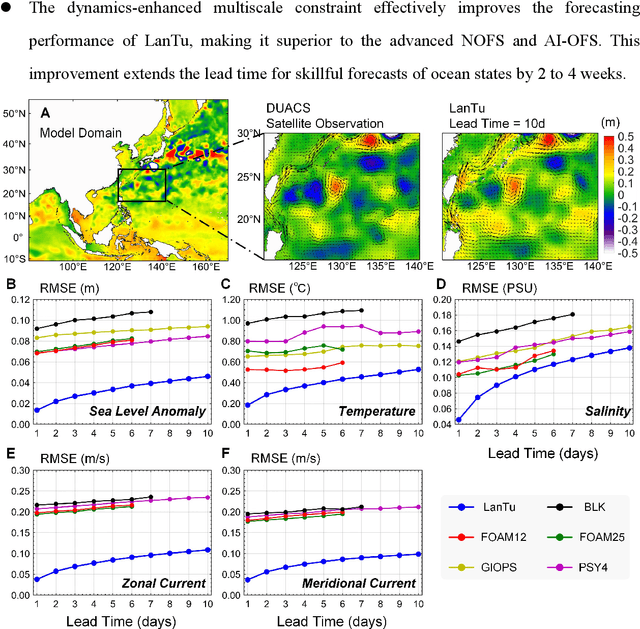
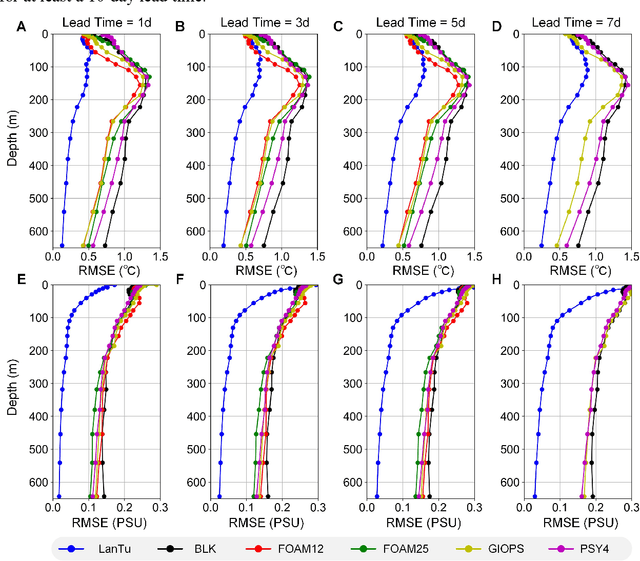
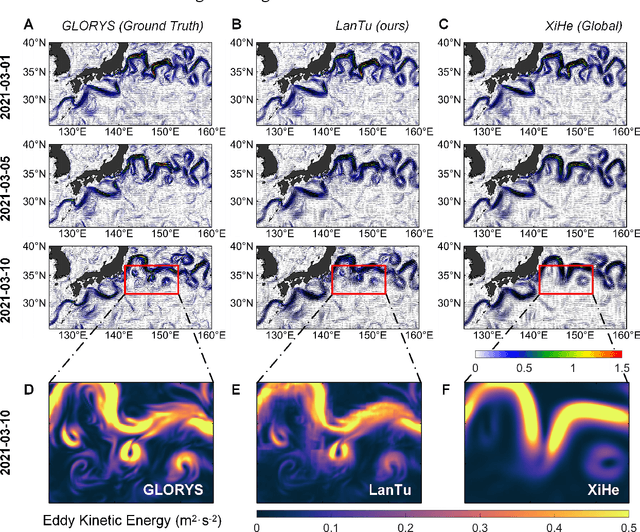
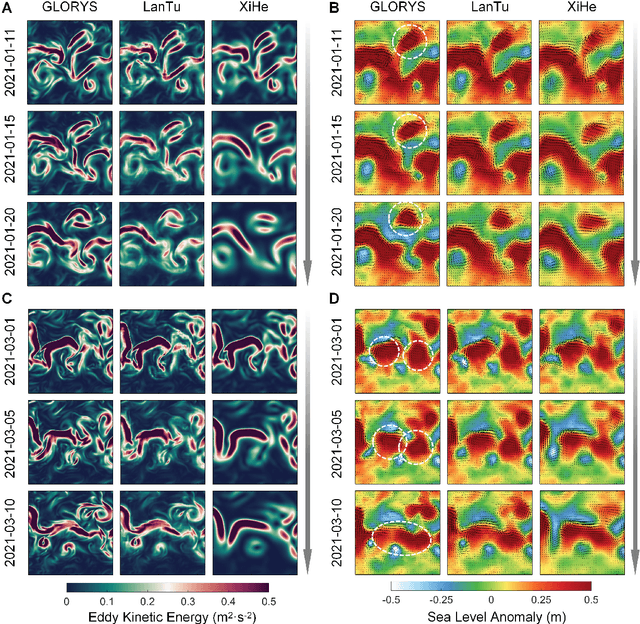
Abstract:Mesoscale eddies dominate the spatiotemporal multiscale variability of the ocean, and their impact on the energy cascade of the global ocean cannot be ignored. Eddy-resolving ocean forecasting is providing more reliable protection for fisheries and navigational safety, but also presents significant scientific challenges and high computational costs for traditional numerical models. Artificial intelligence (AI)-based weather and ocean forecasting systems are becoming powerful tools that balance forecast performance with computational efficiency. However, the complex multiscale features in the ocean dynamical system make AI models still face many challenges in mesoscale eddy forecasting (especially regional modelling). Here, we develop LanTu, a regional eddy-resolving ocean forecasting system based on dynamics-enhanced deep learning. We incorporate cross-scale interactions into LanTu and construct multiscale physical constraint for optimising LanTu guided by knowledge of eddy dynamics in order to improve the forecasting skill of LanTu for mesoscale evolution. The results show that LanTu outperforms the existing advanced operational numerical ocean forecasting system (NOFS) and AI-based ocean forecasting system (AI-OFS) in temperature, salinity, sea level anomaly and current prediction, with a lead time of more than 10 days. Our study highlights that dynamics-enhanced deep learning (LanTu) can be a powerful paradigm for eddy-resolving ocean forecasting.
Generating Unseen Nonlinear Evolution in Sea Surface Temperature Using a Deep Learning-Based Latent Space Data Assimilation Framework
Dec 18, 2024



Abstract:Advances in data assimilation (DA) methods have greatly improved the accuracy of Earth system predictions. To fuse multi-source data and reconstruct the nonlinear evolution missing from observations, geoscientists are developing future-oriented DA methods. In this paper, we redesign a purely data-driven latent space DA framework (DeepDA) that employs a generative artificial intelligence model to capture the nonlinear evolution in sea surface temperature. Under variational constraints, DeepDA embedded with nonlinear features can effectively fuse heterogeneous data. The results show that DeepDA remains highly stable in capturing and generating nonlinear evolutions even when a large amount of observational information is missing. It can be found that when only 10% of the observation information is available, the error increase of DeepDA does not exceed 40%. Furthermore, DeepDA has been shown to be robust in the fusion of real observations and ensemble simulations. In particular, this paper provides a mechanism analysis of the nonlinear evolution generated by DeepDA from the perspective of physical patterns, which reveals the inherent explainability of our DL model in capturing multi-scale ocean signals.
AnimateAnything: Consistent and Controllable Animation for Video Generation
Nov 16, 2024
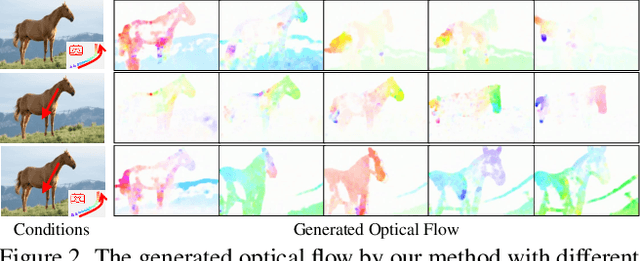


Abstract:We present a unified controllable video generation approach AnimateAnything that facilitates precise and consistent video manipulation across various conditions, including camera trajectories, text prompts, and user motion annotations. Specifically, we carefully design a multi-scale control feature fusion network to construct a common motion representation for different conditions. It explicitly converts all control information into frame-by-frame optical flows. Then we incorporate the optical flows as motion priors to guide final video generation. In addition, to reduce the flickering issues caused by large-scale motion, we propose a frequency-based stabilization module. It can enhance temporal coherence by ensuring the video's frequency domain consistency. Experiments demonstrate that our method outperforms the state-of-the-art approaches. For more details and videos, please refer to the webpage: https://yu-shaonian.github.io/Animate_Anything/.
Linear Chain Transformation: Expanding Optimization Dynamics for Fine-Tuning Large Language Models
Oct 29, 2024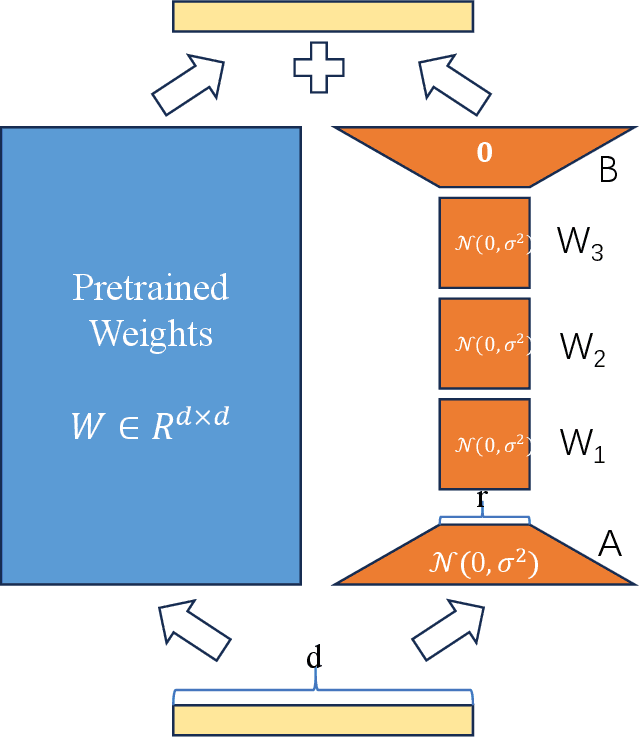
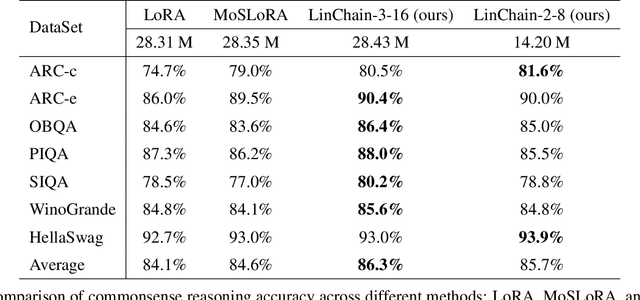
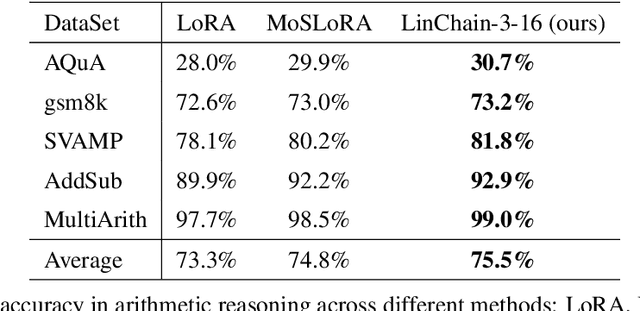
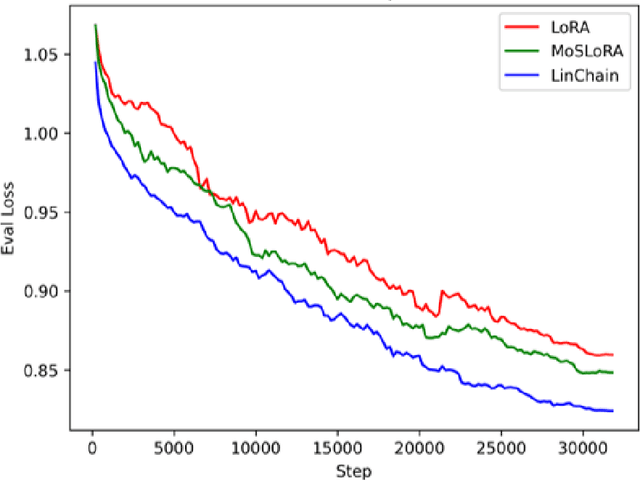
Abstract:Fine-tuning large language models (LLMs) has become essential for adapting pretrained models to specific downstream tasks. In this paper, we propose Linear Chain Transformation (LinChain), a novel approach that introduces a sequence of linear transformations during fine-tuning to enrich optimization dynamics. By incorporating multiple linear transformations into the parameter update process, LinChain expands the effective rank of updates and enhances the model's ability to learn complex task-specific representations. We demonstrate that this method significantly improves the performance of LLM fine-tuning over state-of-the-art methods by providing more flexible optimization paths during training, while maintaining the inference efficiency of the resulting model. Our experiments on various benchmark tasks show that LinChain leads to better generalization, fewer learnable parameters, and improved task adaptation, making it a compelling strategy for LLM fine-tuning.
ATLAS: Adapter-Based Multi-Modal Continual Learning with a Two-Stage Learning Strategy
Oct 14, 2024



Abstract:While vision-and-language models significantly advance in many fields, the challenge of continual learning is unsolved. Parameter-efficient modules like adapters and prompts present a promising way to alleviate catastrophic forgetting. However, existing works usually learn individual adapters for each task, which may result in redundant knowledge among adapters. Moreover, they continue to use the original pre-trained model to initialize the downstream model, leading to negligible changes in the model's generalization compared to the original model. In addition, there is still a lack of research investigating the consequences of integrating a multi-modal model into the updating procedure for both uni-modal and multi-modal tasks and the subsequent impacts it has on downstream tasks. In this paper, we propose an adapter-based two-stage learning paradigm, a multi-modal continual learning scheme that consists of experience-based learning and novel knowledge expansion, which helps the model fully use experience knowledge and compensate for novel knowledge. Extensive experiments demonstrate that our method is proficient for continual learning. It expands the distribution of representation upstream while also minimizing the negative impact of forgetting previous tasks. Additionally, it enhances the generalization capability for downstream tasks. Furthermore, we incorporate both multi-modal and uni-modal tasks into upstream continual learning. We observe that learning from upstream tasks can help with downstream tasks. Our code will be available at: https://github.com/lihong2303/ATLAS.
The Labyrinth of Links: Navigating the Associative Maze of Multi-modal LLMs
Oct 02, 2024Abstract:Multi-modal Large Language Models (MLLMs) have exhibited impressive capability. However, recently many deficiencies of MLLMs have been found compared to human intelligence, $\textit{e.g.}$, hallucination. To drive the MLLMs study, the community dedicated efforts to building larger benchmarks with complex tasks. In this paper, we propose benchmarking an essential but usually overlooked intelligence: $\textbf{association}$, a human's basic capability to link observation and prior practice memory. To comprehensively investigate MLLM's performance on the association, we formulate the association task and devise a standard benchmark based on adjective and verb semantic concepts. Instead of costly data annotation and curation, we propose a convenient $\textbf{annotation-free}$ construction method transforming the general dataset for our association tasks. Simultaneously, we devise a rigorous data refinement process to eliminate confusion in the raw dataset. Building on this database, we establish three levels of association tasks: single-step, synchronous, and asynchronous associations. Moreover, we conduct a comprehensive investigation into the MLLMs' zero-shot association capabilities, addressing multiple dimensions, including three distinct memory strategies, both open-source and closed-source MLLMs, cutting-edge Mixture-of-Experts (MoE) models, and the involvement of human experts. Our systematic investigation shows that current open-source MLLMs consistently exhibit poor capability in our association tasks, even the currently state-of-the-art GPT-4V(vision) also has a significant gap compared to humans. We believe our benchmark would pave the way for future MLLM studies. $\textit{Our data and code are available at:}$ https://mvig-rhos.com/llm_inception.
DiffuX2CT: Diffusion Learning to Reconstruct CT Images from Biplanar X-Rays
Jul 18, 2024

Abstract:Computed tomography (CT) is widely utilized in clinical settings because it delivers detailed 3D images of the human body. However, performing CT scans is not always feasible due to radiation exposure and limitations in certain surgical environments. As an alternative, reconstructing CT images from ultra-sparse X-rays offers a valuable solution and has gained significant interest in scientific research and medical applications. However, it presents great challenges as it is inherently an ill-posed problem, often compromised by artifacts resulting from overlapping structures in X-ray images. In this paper, we propose DiffuX2CT, which models CT reconstruction from orthogonal biplanar X-rays as a conditional diffusion process. DiffuX2CT is established with a 3D global coherence denoising model with a new, implicit conditioning mechanism. We realize the conditioning mechanism by a newly designed tri-plane decoupling generator and an implicit neural decoder. By doing so, DiffuX2CT achieves structure-controllable reconstruction, which enables 3D structural information to be recovered from 2D X-rays, therefore producing faithful textures in CT images. As an extra contribution, we collect a real-world lumbar CT dataset, called LumbarV, as a new benchmark to verify the clinical significance and performance of CT reconstruction from X-rays. Extensive experiments on this dataset and three more publicly available datasets demonstrate the effectiveness of our proposal.
Async Learned User Embeddings for Ads Delivery Optimization
Jun 09, 2024



Abstract:User representation is crucial for recommendation systems as it helps to deliver personalized recommendations by capturing user preferences and behaviors in low-dimensional vectors. High-quality user embeddings can capture subtle preferences, enable precise similarity calculations, and adapt to changing preferences over time to maintain relevance. The effectiveness of recommendation systems depends significantly on the quality of user embedding. We propose to asynchronously learn high fidelity user embeddings for billions of users each day from sequence based multimodal user activities in Meta platforms through a Transformer-like large scale feature learning module. The async learned user representations embeddings (ALURE) are further converted to user similarity graphs through graph learning and then combined with user realtime activities to retrieval highly related ads candidates for the entire ads delivery system. Our method shows significant gains in both offline and online experiments.
 Add to Chrome
Add to Chrome Add to Firefox
Add to Firefox Add to Edge
Add to Edge